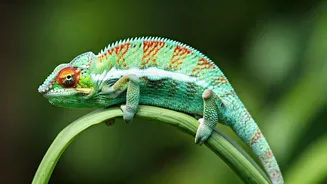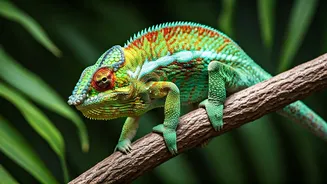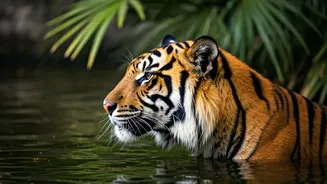Chameleon's Color Show
Chameleons, the quintessential masters of disguise, are renowned for their ability to blend seamlessly with their surroundings. The color-changing prowess
of chameleons isn't merely about camouflage; it's a sophisticated interplay of specialized pigment-containing cells, known as chromatophores. These cells, controlled by the chameleon's nervous system, contain pigments like melanin, which determine colors such as black and brown. But chameleons also have iridophores, crystals that reflect light. These crystals can be manipulated to change how they reflect light, resulting in a display of colors including greens, blues, and yellows. The chameleon's color changes are a response to a combination of factors, including temperature, mood, and social interactions, making each transformation a dynamic expression of their environment and internal state. The capacity of a chameleon to change color is so sophisticated that it stands out as one of the marvels of the animal kingdom.
Octopus's Camouflage Skills
Octopuses demonstrate an exceptional ability to mimic their environments, using specialized cells similar to those of chameleons, called chromatophores. These chromatophores are filled with pigments that can expand or contract, enabling the octopus to instantly change color and pattern. Beyond chromatophores, octopuses also possess iridophores, which, like those in chameleons, reflect light and create iridescent effects. Additionally, they use leucophores, cells that reflect ambient light to match their surroundings. This combination of tools allows octopuses to blend seamlessly with their habitats, whether they are navigating the coral reefs or the sandy ocean floors. This advanced camouflage is essential for both defense, avoiding predation, and hunting, allowing them to ambush prey with ease. The octopus's capacity for rapid color and texture alteration places it among nature's most skilled camouflage artists.
Cuttlefish's Versatility
Cuttlefish are close relatives of octopuses and share their extraordinary color-changing abilities. Like octopuses, cuttlefish employ chromatophores, iridophores, and leucophores to achieve remarkable camouflage. They can rapidly change their skin's color, pattern, and texture to match the seabed, rocks, or any other element of their environment. Cuttlefish do not just use color for disguise; they also utilize it for communication and courtship displays. During mating rituals, male cuttlefish will display vibrant patterns to attract mates, and these patterns can change in an instant, creating a spectacular visual performance. These complex patterns also provide information about their social status, allowing other cuttlefish to read their intentions. The sophisticated nature of the cuttlefish's color-changing abilities highlights the complexity and diversity of marine life.
Flatfish's Bottom Dwelling
Flatfish are bottom-dwelling marine creatures famed for their ability to blend in with the seafloor. They achieve this remarkable feat via chromatophores, similar to the other color-changing animals mentioned. They can shift between a range of colors and patterns, effectively disappearing into the sandy or rocky bottoms where they live. The flatfish's camouflage is essential for avoiding predators, like sharks and seals, and for ambushing prey, such as small fish and crustaceans. This camouflage mechanism is triggered by visual signals received from the environment, allowing flatfish to actively adapt to changing backgrounds. Their capacity to quickly adapt to the surrounding environment contributes to their effective survival strategy. This capacity for camouflage is crucial to their ability to survive in a predator-rich setting.
Squid's Dynamic Skin
Squids, another member of the cephalopod family, are famous for their ability to rapidly change color. They use chromatophores to display a broad spectrum of colors and patterns, much like their cousins, the octopus and the cuttlefish. Squid’s skin contains iridophores, which create iridescent effects. This array of tools enables squids to camouflage themselves in their ocean environments, from the shallow reefs to the deep sea. They use color changes for various purposes, including camouflage to evade predators, communicating with other squids, and attracting mates. The rapid and complex color-changing abilities of squids underscore the sophistication of their nervous systems. This quick-adaptation is crucial for their survival and social interactions, making them dynamic and adaptive members of the marine ecosystem.
Frogs' Adaptive Defense
Certain frog species have developed color-changing capabilities, although their methods and uses vary. Some, like the poison dart frog, use bright warning colors to deter predators, a tactic called aposematism. Others, such as tree frogs, are adept at blending with the environment. The color changes in frogs often depend on factors like temperature, lighting, and even stress levels. Their skin contains special pigment cells, similar to other color-changing animals, that can expand or contract to alter skin color. Frogs often use these adaptations for camouflage, which helps them avoid predators and ambush prey. The frog's capacity for color modification reveals the diverse array of survival methods in the amphibian world and underscores the adaptability of these animals.








